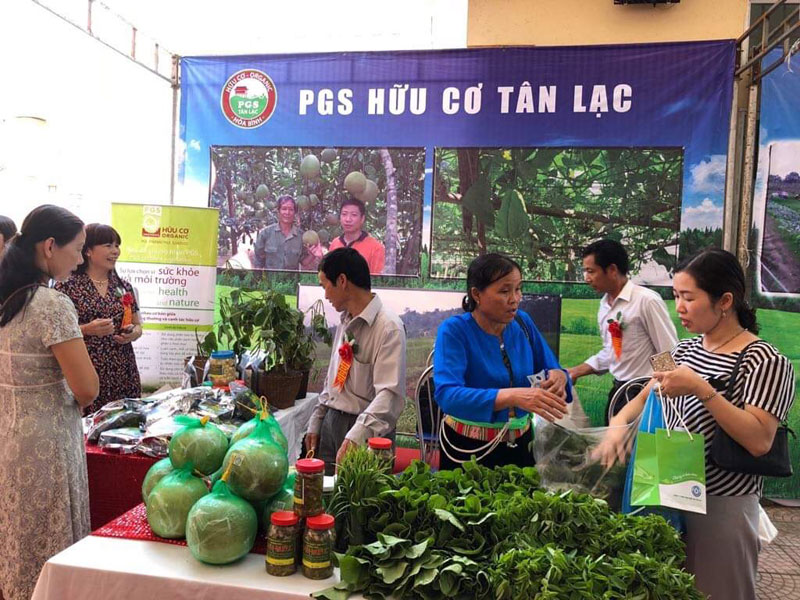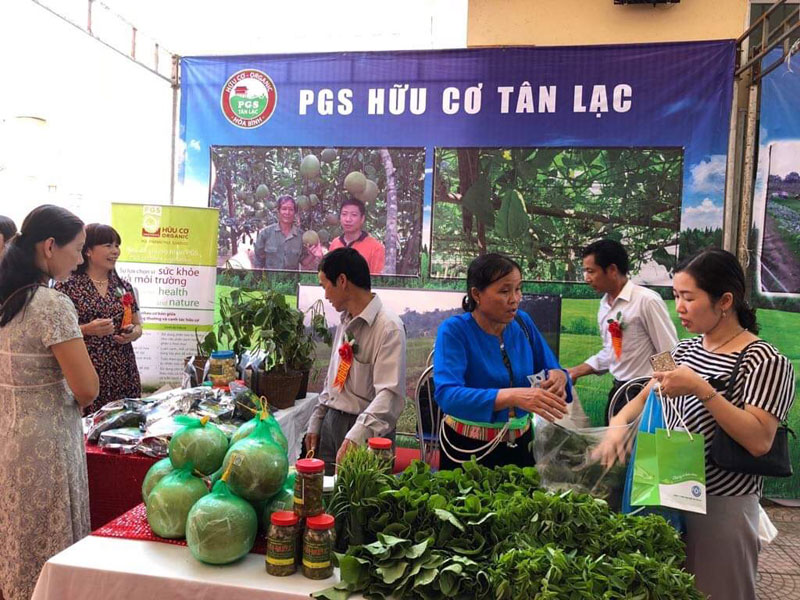
(HBO) – Tan Lac district in the northern mountainous province of Hoa Binh is working to remove bottlenecks for safe vegetable production as it has not yet set up any clean vegetable store.

Popularising local products at organic agricultural fairs is considered as the initial
step of Tan Lac district to seek consumption markets for its vegetables.
The
first safe vegetable cultivation cooperative group was set up in Sung hamlet,
Thanh Hoi commune, which focuses on growing seasonal crops with main vegetables
such as mustard greens, amaranth, aubergine, wax gourd, and cucumber.
According to head of the cooperative group Bui Van Thuan, the cooperative group
has been operational in four years, and some 2-3 hectares of land were zoned
off for plantation of safe vegetables. However, they are being sold at the same
prices as those without clear origin.
Thuan attributed the results to the fact that the vegetables have not been put
into the value chain, and they have no brand registration for consumers to
compare.
About 8-10 years ago, the mountainous communes of Quyet Chien, Ngo Luong, Lung
Van and Nam Son successfully expanded chayote plantation with the support of
the provincial Department of Science and Technology. Currently, chayote is
being grown in an area of nearly 95 hectares, 60 hectares of which are in Quyet
Chien commune. Particularly, there are 25 hectares in the commune receiving
VietGAP certification.
Local efforts in promoting good agricultural practice, building brands and
developing markets have paid off. Quyet Chien chayote has ridden out of the
shade of the same vegetable in Vinh Phuc province’s Tam Dao district, and has
been favoured by consumers after hitting the shelves of supermarkets in Hanoi.
In addition, thanks to favourable climate,
farmers in Tan Lac’s mountainous communes have developed non-traditional crops
such as tomato, cabbage and Korean beet on an area of 5 hectares./.
Since the beginning of this year, under the direction of the Department of Agriculture and Environment, the Sub-Department of Agricultural, Forestry, and Fishery Product Quality Management has strengthened the integration of the professional activities to promote and guide the organizations and individuals in the production and trading of agricultural, forestry, and fishery products to comply with the legal regulations regarding the use of chemicals, pesticides and veterinary medicines in crop cultivation, livestock farming and aquaculture. They also provide guidance to processing and manufacturing establishments on keeping the records to trace the product origins and using food additives from the approved list according to the regulations.
Hoa Binh province saw a significant rise in state budget revenue in the first two months of 2025, heard a meeting chaired by Vice Chairman of the provincial People’s Committee Quach Tat Liem.
Ha Thi Ha Chi, a 26-year-old graduate in law, has taken an unconventional path by returning to her hometown in Mai Chau district to establish the Tong Dau Cooperative, creating stable jobs for local women and bringing Thai ethnic brocade weaving to the global market.
As the Lunar New Year 2025 approached, pork prices surged, creating a profitable season for farmers in Tan Vinh commune, Luong Son district. Taking advantage of the rising demand, Can Minh Son, a farmer from Coi hamlet, sold over 30 pigs at 69,000 VND/kg, each weighing more than 100 kg. After deducting expenses, his family earned a profit of over 50 million VND.
alternate member of the Central Party Committee, Secretary of the Hoa Binh provincial Party Committee Nguyen Phi Long on March 5 had a working session with Yan Jiehe, Founder and Chairman of the China Pacific Construction Group, one of China's largest private corporations in the field of transport infrastructure. Deputy Secretary of the provincial Party Committee, Chairman of the provincial People's Committee Bui Duc Hinh and leaders of provincial departments and sectors also attended the working session.
The electronic printed circuit board (PCB) manufacturing and processing plant of Japan’s Meiko Group, located at Da River Left Bank Industrial Park in Hoa Binh city with a total investment of over 200 million USD, is expected to create thousands of jobs and make a significant contribution to the local budget.



